Research Article, Int J Ment Health Psychiatry Vol: 10 Issue: 1
Soulhacker: An Artist-Medical Collaboration to Treat Depression via Artistic Virtual Reality
Georges Otte1*, Dirk De Ridder1,2, Eric Joris3, Isjtar Vandebroeck3 and Kristin S. Williams1,4,5
1Department of Clinical Neuropsychiatry, BRAI3N Clinic, Gent, Belgium
2Department of Clinical Neurosurgery, University of Otago, New Zealand, USA
3Department of Clinical Neurosurgery, CREW Brussels, Gent, Belgium
4Department of Bioethics, Columbia University, New York, USA
5Neurophysiology Fellow, Society of Brain Mapping Therapeutics, Los Angeles, USA
*Corresponding Author: Georges Otte,
Department of Clinical Neuropsychiatry, BRAI3N Clinic, Gent, Belgium
E-mail: georges.otte@telenet.be
Received date: 29 February, 2024, Manuscript No. IJMHP-24-128574;
Editor assigned date: 04 March, 2024, PreQC No. IJMHP-24-128574 (PQ);
Reviewed date: 18 March, 2024, QC No. IJMHP-24-128574;
Revised date: 25 March, 2024, Manuscript No. IJMHP-24-128574 (R);
Published date: 01 April, 2024, DOI: 10.4172/2471-4372.1000244
Citation: Otte G, Ridder DD, Joris E, Vandebroeck I, Williams KS, (2024) Soulhacker: An Artist-Medical Collaboration to Treat Depression via Artistic Virtual Reality. Int J Ment Health Psychiatry 10:1.
Abstract
"Soulhacker" is a pilot study that results from collaboration between artists and health care providers and is aimed at exploring the potential benefits of an artistic implementation of Virtual Reality (VR) to treat depression and anxiety. Soulhacker creates a VR environment that embeds a metaphorical engaging model of active patient agency inspired by the work of Milton Erickson. It creates a new level of VR "presence" that can have therapeutic or transformative effects. Participants reported positive short-term effects on their mood (arousal, valence and control) and presented statistical significant changes in brain electrical activity in hubs belonging to sensimotor and default mode brain network as measured by qEEG, that are consistent with previous research. These beneficial preliminary results warrant a further larger randomized controlled study to verify those promising effects and positioning of this new form of psychotherapy within existing modalities.
Keywords
Virtual reality; Depression
Abbreviations
Virtual Reality (VR); Post-Traumatic Stress Disorder (PTSD); Obsessive–Compulsive Disorder (OCD); Self-Assessment Manikin (SAM); Head-Mounted Display (HMD), Beck Depression Inventory (BDI); Hospital Anxiety and Depression Score (HADS); Self-Assessment Manikin (SAM); Default Mode Network (DMN); Broadmann Areas (BAs); Salience Network (SN); Default Mode Network (DMN), Central Executive Network (CEN); Medial Prefrontal Cortex (mPFC); Posterior Cingulate Cortex (PCC); Temporoparietal Junction (TPJ)
Introduction
The rise in mental health issues, such as depression, burnout, anxiety, and addiction, has led to the exploration of many novel therapeutic approaches [1-3]. In addition to traditional methods such as psychotherapy, antidepressants, and electroconvulsive therapy, new methods such as psychedelics, neurofeedback, transcranial magnetic stimulation, electrical neurostimulation and new forms of non-invasive neuromodulation and deep brain stimulation are being explored [4,5].
One such method is a non-traumatic psychotherapeutic approach developed by Dr. Milton Erickson, known as hypnotherapeuticinduced dynamic metaphoric therapy. While Milton Erickson was essentially pragmatic and goal oriented, he had no intention of creating a new theory in psychology [6]. His method that acquired a reputation akin to fame, of being very effective with excellent and fast clinical results was based on clear principles such as working on a deep emotional and symbolic level and granting patients great autonomy in the therapeutic process. However, it also had limitations, such as the need for skilled hypnotherapists, the patient's willingness to participate in hypnosis, (a procedure often perceived as giving up control) and a lack of blinded and comparative studies that are needed to gain general academic acceptance. However, the utility of using metaphors (verbal images with transformative potentiality) is as basic to human psychology as axioma’s are to mathematics.
The method, currently described, called "Soulhacker," seeks to overcome those limitations mentioned above while maintaining the core principles of the Ericksonian method. By utilizing virtual reality technology and incorporating new innovative artistic elements, we hope to make this form of therapy more accessible and even more effective.
Virtual reality in psychiatry
Virtual Reality (VR), since 2005 also applied to the field of neuropsychiatry has a growing track record of successful applications in industry, the military, gaming, and medical domains such as revalidation both for somatic and cognitive problems [7]. In psychiatry VR has been gaining momentum as a tool for treating mental health disorders, with a growing body of research showing its effectiveness in treating conditions such as Post-Traumatic Stress Disorder (PTSD), phobias, and anxiety [8-14].
A PubMed search resulted in over 1,000 articles on the use of VR in psychiatry, with a small but increasing number focused on anxiety and affective disorders. Most VR applications in psychiatry to this date have been developed to aid cognitive behavior therapy, such as social and cognitive abilities, exposure therapy, PTSD, OCD, stress mediation, and pain relief [15].
A 2020 review by Cieslik of studies on the use of VR in psychiatry found evidence supporting the positive impact of VR therapy in psychiatric disorders, but the impact varies depending on the disorder being studied [16]. The authors of the review emphasized the need for further research in this area, especially as VR technology continues to evolve.
Another more recent study by Hongqidi et al., found that exposure to restorative VR scenery had healing effects on patients with mild to moderate depression [17]. They found reduced anxiety, improved cognitive function, decreased counterproductive thoughts and a generally stimulation of positive feelings such as well-being and control.
How to measure the effect of VR on brain network dynamics?
The Soulhacker VR experience is a combination of artistically created visual scenes, somatosensory stimulation (IR lamp glow) and auditive elements (voiced guidance) all merged into a dynamic and metaphor rich world, intended to trigger generic positive emotions, reduce anxiety and depression and improve a general level of wellbeing and relaxing self-reflection.
While evaluation of mood is generally done using semi structured self-reporting on valence, arousal en control (dominance) the ultimate goal is to evolve toward a more objective direct analysis of mood as reflected in brain electrical activity [18]. With that goal in mind, we collected besides the analog mood scores (SAM: Self-Assessment Manikin) also 19 channels of qEEG recordings of 5 minutes eyes closed before and after the VR experience.
The use of current source density (Laplacian transform of surface EEG voltage time series recorded at the scalp) is a new tool in EEG analysis made possible by the use of the (family of) Loreta algorithms. Kamarajan et al., discussed its usefulness in diverse psychiatric disorders [19-21].
In a pilot study in 2018 Tarrant used quantitative EEG analysis to compare relaxation induced by VR to a simple state of quiet rest [22]. Using current source density (sLORETA) analysis, the authors found that the VR induces a shift to lower beta power especially in the anterior cingulate cortex (part of the salience network and congruent with a reduction of anxiety [23,24].
"While spectral band analysis of EEG recordings in meditation specialists tends to show that relaxation is related to an increase in alpha and theta power, modern electrical neuroimaging techniques that can calculate generating sources from surface-recorded EEG voltage time series provide a better understanding of the changes VR experiences can induce in brain dynamics [25-27]. Current source density estimation methods (such as swLORETA, the newer weighted sLORETA variant offers better temporal and spatial resolution (deep sources) and hence allow for a dynamic view of brain networks related to higher cortical functions and emotional regulation [28].
In a recent study published in the journal Psychophysiology (2022), quantitative EEG analysis techniques were applied to compare power spectral density and an increase of power in the beta band (11-30 Hz) in the parietal, occipital, and frontal lobes was identified [29]. This was higher with 360° surround video immersion than with simple 2D VR screen watching. They also observed increased fronto-occipital functional connectivity with parietal and temporal networks. The authors conclude that immersion in 3D space has a more robust effect on visual attention, visual perception, and other visual-related cognitive information processing processes.
On safety and ethics in the use of VR in psychotherapy
As VR is a powerful technology, its use with psychological vulnerable patients justifies a separate discussion of some important ethical aspects of its implementation [30]. VR is not without potential side effects, such as simulator sickness, balance problems and falls, derealization, visual irritation, or the danger of triggering affective or mental decompensation and even panic attacks or psychotic reactions. Therefore, its use with patients with depression requires extra care and close expert psychotherapeutic supervision.
The assurances of patient safety on both the physical and psychological levels were important ethical cornerstones in the Soulhacker study. At the level of ethics, we ensured the presence at all times of a trained neuropsychiatrist and a technical assistant who (invisibly to the patient) were present to assure his/hers physical safety (fall and collision prevention). We explicitly stress that VR is not meant as a replacement for psychotherapy, but only as an add-on tool in a psychotherapeutic framework. Respect for patient choice, physical and mental safety and a strong focus on patient agency were the main, non-negotiable ethical principles of this project. Even when taking off the HMD at the end of the VR session, care was taken to do so slowly, to make the transition from VR to the real world as progressive as possible, without inducing vertigo, unsteadiness, or anxiety.
Keeping the sessions short (15 minutes) without sacrificing the therapeutic and metaphoric strength of their content, embedding continuous auditory therapeutic presence, allowing patients full autonomy while exploring and interacting in the VR world, granting them a safety first form of agency and control in movements and actions that change their VR environment from a dark and gloomy place to a mood-uplifting, sunny, and colorful scenery, and avoiding simulator sickness by coupling each movement in the virtual world to a one-on-one corresponding movement in a large physical space (empty space) makes this Soulhacker study innovative. In our study group of 27 patients, there here were no physical or any mental negative side effects.
Goal of the study
While incorporating the core ideas of Ericksonian metaphoric hypnotherapy into a virtual reality environment, Soulhacker adds free body movement to the VR scene, grants patients a high degree of agency and autonomy, provides physical and psychological safety (fall prevention), and uses a non-directive, psychotherapeutic voice guidance during the session. A professional actor trained the psychiatrist in setting up the language needed to induce a feeling of comfort and safety while granting complete autonomy, or "freedom," to the patient. Directives such as "go there, do that" were avoided. Instead, patients were "invited" to freely try this or that, and changes to the VR environment caused by patient actions were labeled as “patient creations”. Language was carefully selected to be in sync with this general principle. Granting agency to patients reflects ethical concerns and respect for patients autonomy which is be considered as the hallmark of modern social psychiatry.
The primary goal of the study was to see if positive mood upregulation could be correlated to dynamic changes in brain hubs and networks (at the source level) using swLORETA qEEG analysis of pre and post-EEG recordings.
Materials and Methods
Participants
This study was approved by the UZA ethical committee (Antwerp University, Belgium) (ID 0596 B3002021000200). Twenty-seven people participated in the study. They were recruited on voluntary basis from two practices and from surveys on social media. A small monetary compensation was offered when requested to compensate for transportation costs. As the study was aimed at patients suffering from minor to moderate depression, a BDI-score (Beck Depression Inventory) above 30 or a HADS-score (Hospital Anxiety and Depression Score) above 12; suicidal ideation and antecedents of psychosis were considered exclusion criteria. In total there were 13 male and 14 female patients. Age range was 30-65 Y. Except for two patients who had experienced VR in an occasional recreational setting; the patients were completely VR naive.
Study setup and procedure
Two weeks before the start of the study all volunteers received a detailed, photo-illustrated patient brochure explaining the goal of the study and outlining every step of the setup and procedure. They all had a recent BDI and a HADS inventory.
On arrival at the location (Gent, Belgium), patients were welcomed into a separate office by the study leader, a trained psychiatrist, who re-explained the goal of the study and asked participants if they had read the brochure and if there were any additional questions or any need for clarification. They were then invited to inspect the adjacent large empty hall (10×5 m), which served as the physical space, and to meet with the technical assistant of CREW, the art VR Company, who would accompany them throughout the walk to guarantee their physical safety by preventing collisions or falls. The assistant then showed and explained in detail all elements of the complete VR equipment to the patient. When all was clear the patient was invited to sign an informed consent document and fill out a pre-test mood questionnaire (mannikin score of valence, arousal, and control cf Figure 1).
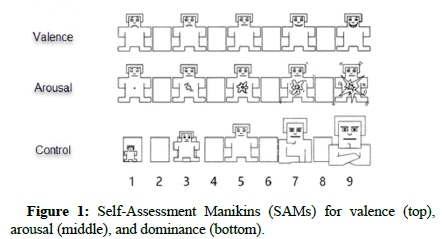
Figure 1: Self-Assessment Manikins (SAMs) for valence (top), arousal (middle), and dominance (bottom).
Then, a pre-test 5-minute artefact free qEEG was registered with eyes closed. The qEEG device was based on a Mitsar 201 24 channel amplifier, Neuroguide (ANI®) registration software and free cap gelfree electrode cap. (IFEN® thomas feigner). Using a gel free system was important as not to mess up the hair of our volunteers especially as the qEEG recordings were done outside a regular EEG neurophysiological lab. Recording quality with the free caps was outstanding. All impedances were below 20 k Ohm and signal quality was satisfying. While still wearing the EEG cap (but detached from the amplifier), they were then equipped with the VR gear (Figure 2). And underwent some audio-visual testing after this, the VR walk began. Following the VR experience, a post-VR qEEG was taken (again, a 5-minute eyes closed registration) and a post-VR mood questionnaire was completed. This was followed by an open-question interview to scan for side effects, and a final debriefing, during which participants were given money for refreshments and/or compensation for transportation costs if desired. Most patients reported that they found the experience uplifting and expressed a desire to participate in further experiments of this type. Blinded 3rd party signal analysis and statistical testing of pooled before VR versus after VR qEEG was performed on swLORETA derived current source density as reflective of brain network activity and statistical analysis (one sample T tests) were performed using Neuroguide normal values database, Neuronavigator and Navistat software (ANI® Dr.Robert Thatcher director) by Dr. K. Williams PD (Columbia University New York- USA).
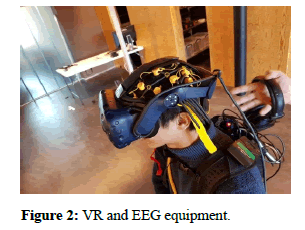
Figure 2: VR and EEG equipment.
The soulhacker VR architecture
The Soulhacker VR world was developed by Belgian artistic company “CREW” under the direction of Mr. Eric Joris and Isjtar Vandebroeck. The scenes were composed of 3D-scanned and artistically rendered landscapes (chapel, forest, cathedral) as its basic elements. An elaborate tracking system monitored the patients' head, hands (using controllers), pulse frequency and geospatial localization in the virtual world. The VR world was also displayed on a large external screen, allowing the therapist to monitor the patient's walk and use a dialog voice channel (Figure 3).
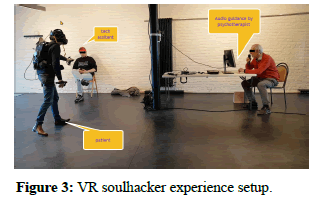
Figure 3: VR soulhacker experience setup.
The Soulhacker's world presented at a subliminal level metaphorically transformative imagery as inspired by Dr. Milton Erickson as explained below [31-33].
The Soulhacker VR experience
Patients began their walk in a lobby with high walls and gothic windows, but without a clear exit door. While they were invited to explore the initial space and look out the windows at the exterior forest, they were unable to find an easy exit until the therapist invited them to test if the walls could be stepped through if the subject simply tried. This is obviously a resilience stimulating metaphor for the subliminal “coping” message stating that even if problems in perception may look large or at first sight impossible to solve, there may exists solutions they can only find by persistently trying out-ofthe- box strategies to tackle the problem and find new ways to move on. It is the stoic message by Seneca stating that we often suffer more in our imagination then in reality. All patients reached the forest (gray, dark, and gloomy), which they could safely explore (Figure 4).
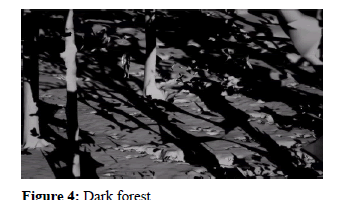
Figure 4: Dark forest.
Message: Do not develop avoidance when confronting anxiety inducing situations learn to look your fears in the eye”. After exploring, they discovered a shining, colorful, but small miniature Marquette of a cathedral floating in midair. As they approached and explored this contraption, they were transported inside a large, spacious cathedral-like edifice. After again exploring this space, they discovered green crystal balls lying on the concrete floor. They could grasp, lift and visually examine these balls (each transparent crystal ball contained a small bonsai) and throw them to a spot in the room where they wanted more light (Figure 5). Upon scattering the glass, the trees began growing and expanding very quickly, illuminating the neighboring space with light emanating from their delicate pixelated foliage. There were seven of these crystal balls to be discovered, and as each tree grew larger, it generated more light until the space was transformed (by the actions of the patient) into a colorful, relaxing rainforest with warm green light (Figure 6).
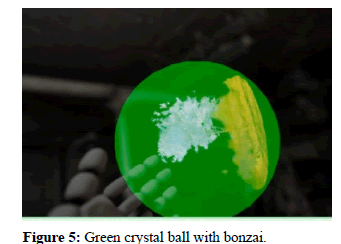
Figure 5: Green crystal ball with bonzai.
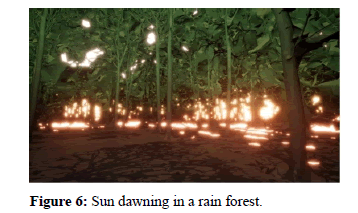
Figure 6: Sun dawning in a rain forest.
This is the core metaphor of Soulhacker where a patient will autonomously transform a dark place into a relaxing and vitalizing natural environment. The patient is the author of this enlightenment. It is not the pill, not the therapist but the patient himself who sets this vital transformation in motion.
While patients were seated, they were invited to contemplate the green forestall scene in all its glory as it was gradually highlighted by a "warm summer" sunrise (using an IR lamp to create the feeling of warm sunrays close to the patient's face).
Message: Give yourself time to relax and enjoy nature as you uncovered and discovered it. You are a holistic part of this planet.
They were free to relax and visually scan all the details of the forest they had created. The end of the VR experience was then announced, and the technical support helper gently removed the controllers, headphones, backpack PC, and slowly the Head-Mounted Display (HMD) to avoid any sudden mental or physical disorientation when reentering the "real world."
Outcome metrics
Measures for mood and brain electrical network activity: Carving out what is defined by Chalmers as “qualia”, emotions are at the core of conscious awareness boarding the demarcation zone between carbon based biological versus silicon based AI. Their measurement be it qualitatively versus quantitatively (indirect) is the mean toolkit that studies deploy to evaluate the clinical effect of different therapeutic strategies [34].
Classical as well as a 3D Self-Assessment Manikin Scale (SAM) including arousal, valence and dominance (control) questionaries were taken from each volunteer before and after the VR experience. Valence and arousal are however not completely independent and brain processing follows that rule with separate processing nodes and network hubs for high arousal high valence versus high arousal low valence mood states. Moreover, in normal daily life there is a strong language bias towards positive emotions. While mood and sentiment registration among axis of valence, arousal and control can be useful as a quick subjective screening, the main information is in the changes induced by the VR experience in different brain networks. Given the better time resolution of EEG we added pre and post VR qEEG registrations in order to allow a statistical comparison of source analysis using swLORETA of derived current density [35].
Results
Mood questionnaire
Mood questionnaires comparing pre and post-VR experiences were completed using a self-assessment mannikin form that measured arousal (blue), valence (orange), and control (grey). The improvement scores in these dimensions are shown for each patient (differential score of improvement) (Figure 7).
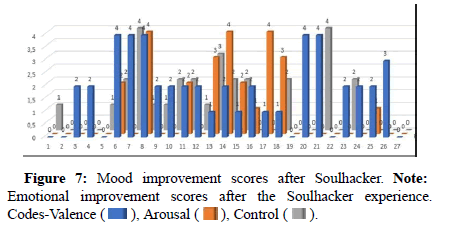
Figure 7: Mood improvement scores after Soulhacker. Note: Emotional improvement scores after the Soulhacker experience. Codes-Valence ( ), Arousal (
), Arousal ( ), Control (
), Control ( ).
).
Of the 27 participants only 4 reported no change at all. 23 participants showed marked improvement in one or more mood qualifiers. The histogram shows the improvement score (after-VR scores minus pre-VR scores). Codes-Valence: Blue bars; Arousal: Orange bars; Control: Grey bars. No negative side effects were reported. At debriefing, many participants reported to have generally enjoyed the experience and would not mind more or longer sessions. Some suggested adding features such as a larger physical space, some intermediate resting points, and a musical environment. However, music, having a specific cultural effect and potentially strong impact on mood and brain function was specifically excluded in our study in order not to bias the effects of the VR.
qEEG analysis
Data analysis was done of line by a masked third party author (Dr. KW) trained in qEEG, Neuroguide and statistics.
Results were obtained for every bin.
General findings
Delta, theta and alpha band showed no statistically significant alterations in current density at source level.
Statistical significance was only observed in 14-20 Hz beta range. Detailed analysis is summarized in a table presenting the frequency bins versus the Brodmann areas showing Ba’s with statistically significant changes in CSD after the VR experience.
The qEEG data showed a statistically significant effect in the mid to high beta range with 18-20 Hz beta activation of the primary visual cortical integration hubs (Brodmann area’s) (Ba17 and Ba18) while lower beta range (16 Hz) showed activation in salience but especially in hubs belonging to Default Mode Network (DMN) (PCC and hippocampus) (Figure 8).
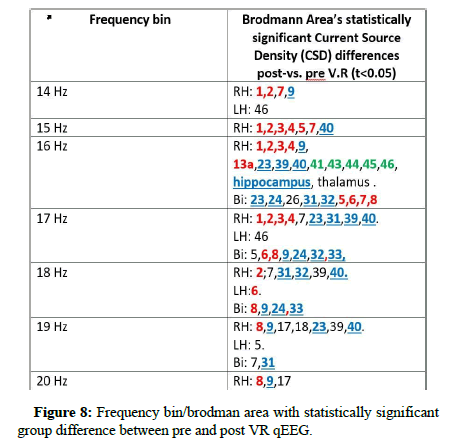
Figure 8: Frequency bin/brodman area with statistically significant group difference between pre and post VR qEEG.
Statistical significant differences are seen in several Brodman areas involving sensi-motor cortex, secondary motor cortex, motor planning and control, motor imagery and learning (1,2,3,4,5,7,8,13,) and working memory (41,43,44,45,46)
Others are centered on hubs belonging to the DMN: Frontal: (8,9,10); Temporal (21,28,36); Posterior Cinguli: (23,24); Ant. Cinguli: (32); Hippocampus: (29,30,31); Parietal: (39,40).
Some screenshots of the navistat data analyzer
The Navistat is an add on module to Neuronavigator and Neuroguide (ANI software) allowing statistical analysis between pre and post-procedure qEEG registrations in grouped data. Only statistically significant results (paired T test analysis) between current source density area’s (measured with swLORETA) are withheld (t statistic<0.05) for every 1 Hz frequency bin from 1 to 20 Hz.
There were no significant differences below 16 Hz.
16 Hz: Broadmann Areas (BAs) that approached statistically significant alterations across the pre and post analyses in the 16 Hz bin include BAs 1, 13a, 2, 23, 3, 39, 4, 40, 41, 43, 45, 46, hippocampus, thalamus, and 9 within the right hemisphere. Furthermore, bilateral alterations were observed in BAs 23, 24, 26, 31, 32, 33, 5 and 6, 7, 8 (Figure 9).
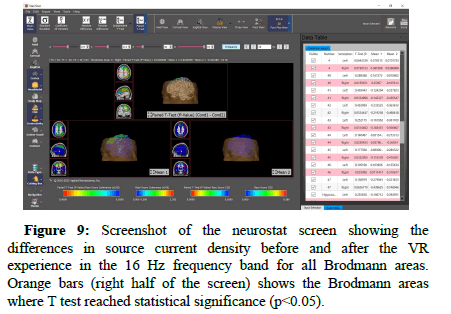
Figure 9: Screenshot of the neurostat screen showing the differences in source current density before and after the VR experience in the 16 Hz frequency band for all Brodmann areas. Orange bars (right half of the screen) shows the Brodmann areas where T test reached statistical significance (p<0.05).
19 Hz: Statistically significant alterations within the 19 Hz bin were focal to BAs 17, 18, 23, 39, 40, 8 and 9 right hemispheres, BA 5 for the left hemisphere, and BAs 31 and 7 bilaterally.
20 Hz: Statistical significance was observed in the 20 Hz bin for BAs 17, 8 and 9 right hemispheres (Figure 10).
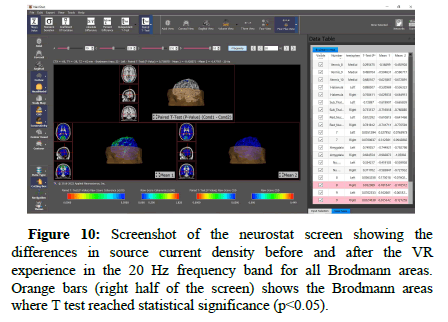
Figure 10: Screenshot of the neurostat screen showing the differences in source current density before and after the VR experience in the 20 Hz frequency band for all Brodmann areas. Orange bars (right half of the screen) shows the Brodmann areas where T test reached statistical significance (p<0.05).
Discussion
We observed that the Soulhacker experience had marked effect on the mood of the participants namely a clear improvement of wellbeing as measured by a Self-Assessment Tool (SAT). EEG registrations, taken at rest eyes closed before and after the VR experience were analyzed at current source density level (swLORETA) with comparative t-statistics showing complex but significant changes in sensi-motor Brodmann areas and in areas of motor imagery planning and learning but also in hubs belonging to the Default Mode Network. There was no increase in the amygdalar region which is compatible with the fact that most patients did not report abnormal increase of anxiety nor panic during the VR experience.
Can we relate changes of those cortical brodmann areas to improvement of mood?
Soulhacker represents a complex environment combining somatosensory and motor activation in a visually rich virtual environment with auditory guidance. We can therefore expect both CSD differences in the cortical regions serving these higher functions (somatosensory cortex, motor cortex, visual associative and auditory associative cortex). These findings are in line with the results from a recent similar study by Li and collaborators [17].
However more important was the fact that we found also a clear activation of dorsolateral and medial prefrontal cortex, parietal and midtemporal cortex, posterior and precuneate cortex and hippocampus. These areas and are also hubs of the Default Mode Network (DMN) [12,36-40].
The default mode network is a network formed by a series of cortical and subcortical hubs that are active when a subject is awake and alert but not actively engaged in external attention demanding task. It is postulated that in the normal individual the DMN is involved in self-referential and introspective processes, such as mindwandering, mental simulation, and memory recall of past experiences and decisions. The DMN also plays a role in the integration of information from various brain regions and is thought to support consciousness and self-awareness (Akeju, 2014). The DMN helps an individual to reflect on his/hers own thoughts, emotions, and experiences and make connections to past events (hippocampus). However, the relation of the DMN to anxiety and depression is complex and both hyperactivation and sub activation patterns have been described in depression. In the triple network theory a pathological pattern of interaction within and between three networks (SN: Salience Network, DMN: Default Mode Network and CEN: Central Executive Network) is the cornerstone to understand depression. A continuous active salience and CEN network processing negative “error” stimuli (left insula en left DLPFC) could fuel the DMN with negative thoughts (rumination) while and exhausted CEN results in cognitive under achieving. Altered functional connectivity in the triple network has become one of the dominant models for explaining the neural basis of symptoms and behavior related to anxiety and depression [41-44].
Conclusion
The Soulhacker pilot study has demonstrated that the Ericksonian metaphore hypnotherapy can be successfully provided via a VR environment and can be useful as a future concept of psychotherapeutic augmentation. In this pilot study the effect of a single VR experience already showed a marked effect on mood (valence, arousal and control) on a visual self-assessment scale but also a statistically significant activation at the source level of brain electrical activity in hubs of the sensi motor cortex, visual association cortex, hippocampus and important hubs of the default mode network. These findings are in line with the results from similar studies.
Soulhacker was fueled from its concept by a strong ethical concern as not to harm patients and therefore stressed the importance of free movement in physical space, securitization of patients (fall and collision prevention), prevention of simulator sickness, augmenting agency of the patient and psychotherapeutic nearness as main attributes. A computer-based system can and should augment but never replace the psychotherapist. Deploying therapeutic and dynamical metaphors in virtual reality offers a powerful and flexible scene for further psychotherapeutic explorations. The use of qEEG to register and document induced functional brain changes in the hubs of concerned brain networks is an important method to objectively measure what effects the VR has on the brain. Moreover, by individually linking symptoms to functional brain networks this technique can easily be extended to become a valuable aid in optimizing and personalizing the VR environment to the individual patient.
Soulhacker has opened not just a window but a completely new portal to psychotherapy shaping its possible future as an augmentation technique deserving a place in the toolkit of every modern psychotherapist in the digital era of tomorrow.
Soulhacker started as an artistic project by the CREW (with Cosmic Flower and Ghent Design fest) and evolved into the neurotherapeutic field. It is therefore “more than meets the eye” which is also the title of an important recent publication by Van Leeuwen. Indeed Soulhacker forms a strong argument to support the vision of these authors stressing the important link between art and neuroscience. They argue that art perception and appreciation is linked to neuroaesthetics by activation of hubs belonging to the social brain connectoma.
The social connectome is thought to involve several key brain regions, including the Medial Prefrontal Cortex (mPFC), Posterior Cingulate Cortex (PCC), Temporoparietal Junction (TPJ), amygdala, and insula. These regions have been shown to be activated during tasks related to social cognition and are thought to play a role in processing social information, regulating social emotions, and integrating social cues.
These regions partially overlap with the Default Mode Network (DMN) that is also thought to play a role in social cognition, as well as in mentalizing (thinking about others thoughts and feelings). The social connectome and DMN therefore share several key nodes, including the mPFC, PCC, and TPJ, which suggest that these regions may play a central role in social processing. However, the social connectome also involves other regions that are not typically considered part of the DMN, such as the amygdala and insula, which are involved in processing social emotions and interoception.
In his seminal work “Inner vision: An exploration of art and the brain” (Oxford University Press 1999) the author, Semir Zeki stated: “Artists are in some sense neurologists studying the brain with techniques that are unique to them, but studying unknowingly the brain and its organization nevertheless”.
Limits of this study and future directions
While innovative and as far as we know being the first of its kind in the matching of an empty physical space to a metaphor rich virtual space, this study is still but a pilot study with a limited number of patients (27), excluding severe depression and with only short-term evaluation of mood and brain network effects. A new replication study is necessary not only to see I the results are consistent and reproducible, if they are persisting over time, if and how they can be augmented and if the system can be scaled to a version that can be deployed in daily clinical practice. Even more progressive applications may be envisaged. For example, due to the fact that multiuser presence in VR space is now possible, we can also put the therapist as an avatar together with the patient into the VR world as a visible and audible trusted companion.
Funding
This study was supported by a research funding. “Innovatieve partnerprojecten. Ministerie van Cultuur, Jeugd and Media interoception”.
Acknowledgement
Special thanks go to all the volunteers that participated in this study. Very special thanks go to Mr Jan Ost and his team at BRAI3N (Jemappestraat 5 Gent (www.brai3n.com) for their efforts to support and actively promote the study.
Dr. Kristin Williams, PhD Columbia Univ NY, USA did the EEG data-analysis using Neuronavigator and Navistat neuroguide software package (one sample T test pre and post VR).
References
- Hatta MH, Sidi H, Koon CS, Roos NAC, Sharip S, et al. (2022) Virtual Reality (VR) technology for treatment of mental health problems during COVID-19: A systematic review. Int J Environ Res Public Health 19: 5389.
- Glowacki DR, Williams RR, Wonnacott MD, Maynard OM, Freire R, et al. (2022) Group VR experiences can produce ego attenuation and connectedness comparable to psychedelics. Sci Rep 12: 8995.
- Viczko J, Tarrant J, Jackson R (2021) Effects on mood and eeg states after meditation in augmented reality with and without adjunctive neurofeedback. Front Virtual Real 2.
- Perez TM, Glue P, Adhia DB, Navid MS, Zeng J, et al. (2022) Infraslow closed-loop brain training for anxiety and depression (ISAD): A protocol for a randomized, double-blind, sham-controlled pilot trial in adult females with internalizing disorders. Trials 23(1): 949.
- To WT, Ridder DD, Hart J, Vanneste S (2018) Changing brain networks through non-invasive neuromodulation. Front Hum Neurosci 12: 128.
- Milton H (2009) Erickson naturalistic techniques of hypnosis. Am J Clin Hypn 51(4): 333-340.
- Vives SMV, Slater M (2005) From presence to consciousness through virtual reality. Nat Rev Neurosci 6(4): 332-339.
- Chirico A, Cipresso P, Yaden DB, Biassoni F, Riva G, et al. (2017) Effectiveness of immersive videos in inducing awe: An experimental study. Sci Rep 7: 1218.
- Freeman D, Reeve S, Robinson A, Ehlers A, Clark D, et al. (2017) Virtual reality in the assessment, understanding, and treatment of mental health disorders. Psychol Med 47: 2393-2400.
- Fodor LA, Cotet CD, Cuijpers P, Szamoskozi S, David D, et al. (2018) The effectiveness of virtual reality based interventions for symptoms of anxiety and depression: A meta-analysis. Sci Rep 8: 10323.
- Geraets CNW, Wallinius M, Sygel K (2022) Use of virtual reality in psychiatric diagnostic assessments: A systematic review. Fron Psychiatry 13: 828410.
- Li BJ, Friston K, Mody M, Wang HN, Lu HB, et al. (2018) A brain network model for depression: From symptom understanding to disease intervention. CNS Neurosci Ther 24(11): 1004-1019.
- Mazza M, Sucker KK, Lemenager T, Kiefer F, Lenz, B (2021) Virtual reality: A powerful technology to provide novel insight into treatment mechanisms of addiction. Transl psychiatry 11(1): 617.
- Wiebe A, Kannen K, Selaskowski B, Mehren A, Thone AK, et al. (2022) Virtual reality in the diagnostic and therapy for mental disorders: A systematic review. Clin Psychol Rev 98: 102213.
- Park MJ, Kim DJ, Lee U, Na EJ, Jeon HJ (2019) A literature overview of Virtual Reality (VR) in treatment of psychiatric disorders: Recent advances and limitations. Front Psychiatry 10: 505.
- Cieslik B, Mazurek J, Rutkowski S, Kiper P, Turolla A, et al. (2020) Virtual reality in psychiatric disorders: A systematic review of reviews. Complement Ther Med 52: 102480.
- Li H, Dong W, Wang Z, Chen N, Wu J, et al. (2021) Effect of a virtual reality-based restorative environment on the emotional and cognitive recovery of individuals with mild-to-moderate anxiety and depression. Int J Environ Res Public Health 18(17): 9053.
- Apicella A, Arpaia P, Mastrati G, Moccaldi N (2021) EEG-based detection of emotional valence towards a reproducible measurement of emotions. Sci Rep 11: 21615.
- Ishii R, Marqui PRD, Canuet L, Xiang J, Gaetz WC (2018) Editorial: New insights on basic and clinical aspects of eeg and meg connectome. Front Hum Neurosci 12: 232.
- Kamarajan C, Pandey AK, Chorlian DB, Porjesz B (2015) The use of current source density as electrophysiological correlates in neuropsychiatric disorders: A review of human studies. Int J Psychophysiol 97(3): 310-322.
- Marqui PRD, Biscay RJ, Bayard BJ, Lehmann D, Kochi K, et al. (2014) Assessing direct paths of intracortical causal information flow of oscillatory activity with the isolated effective coherence (iCoh). Front Hum Neurosci 8: 448.
- Tarrant J, Viczko J, Cope H (2018) Virtual reality for anxiety reduction demonstrated by quantitative eeg: A pilot study. Front Psychol 9: 1280.
- Nejad SY, Beheshti S (2021) Efficient high resolution sLORETA in brain source localization. J Neural Eng 18(1).
- Zhang Y, Zhang L, Hua H, Jin J, Zhu L, et al. (2021) Relaxation degree analysis using frontal electroencephalogram under virtual reality relaxation scenes. Front Neurosci 15: 719869.
- Faber PL, Lehmann D, Tei S, Tsujiuchi T, Kumano H, et al. (2012) EEG source imaging during two Qigong meditations. Cogn Process 13(3): 255-265.
- Jerath R, Barnes V, Wright DD, Jerath S, Hamilton B (2012) Dynamic change of awareness during meditation techniques: Neural and physiological correlates. Front Hum Neurosci 6: 131.
- Kim JY, Son JB, Leem HS, Lee SH (2019) Psychophysiological alteration after virtual reality experiences using smartphone-assisted head mount displays: An eeg-based source localization study. Appl Sci 9: 2501.
- Soler EP, Dolan K, Hadamschek V, Tass PA (2007) swLORETA: A novel approach to robust source localization and synchronization tomography. Phys Med Biol 52(7): 1783-1800.
- Xu X, Sui L (2022) Eeg cortical activities and networks altered by watching 2d/3d virtual reality videos. J Psychophysiol 36(1): 4-12.
- Kellmeyer P, Andorno NB, Meynen G (2019) Ethical tensions of virtual reality treatment in vulnerable patients. Nat Med 25(8): 1185-1188.
- Schott GD (2022) Black and white art: Emotion, intellect and functional specialization in the visual brain. Brain 145(4): 1193-1195.
- Mostajeran F, Krzikawski J, Steinicke F, Kuhn S (2021) Effects of exposure to immersive videos and photo slideshows of forest and urban environments. Sci Rep 11(1): 3994.
- Malkomsen A, Rossberg JI, Dammen T, Wilberg T, Lovgren A, et al. (2022) How therapists in cognitive behavioral and psychodynamic therapy reflect upon the use of metaphors in therapy: A qualitative study. BMC Psychiatry 22(1): 433.
- Lacalli T (2022) On the origins and evolution of qualia: An experience-space perspective. Front Syst Neurosci 16: 945722.
- Morales JM, Trujillo HJL, Greco A, Guixeres J, Llinares C, et al. (2018) Affective computing in virtual reality: Emotion recognition from brain and heartbeat dynamics using wearable sensors. Sci Rep 8(1): 13657.
- Knyazev G (2013) Eeg correlates of self-referential processing. Front Hum Neurosci 7: 264.
- Menon V (2011) Large-scale brain networks and psychopathology: A unifying triple network model. Trends Cogn Sci 15(10): 483-506.
- Ridder DD, Adhia D, Vanneste S (2021) The anatomy of pain and suffering in the brain and its clinical implications. Neurosci Biobehav Rev 130: 125-146.
- Ridder DD, Vanneste S, Smith M, Adhia D (2022) Pain and the triple network model. Front Neurol 13: 757241.
- Thatcher RW, North DM, Biver CJ (2014) LORETA EEG phase reset of the default mode network. Front Hum Neurosci 8: 529.
- Leeuwen VJEP, Boomgaard J, Bzdok D, Crutch SJ, Warren JD (2022) More than meets the eye: Art engages the social brain. Front Neurosci 16: 738865.
- Chabas D (2001) Interview of semir zeki: The art of studying how the brain processes beauty.
- Lin MH, Liran O, Bauer N, Baker TE (2022) Scalp recorded theta activity is modulated by reward, direction, and speed during virtual navigation in freely moving humans. Sci Rep 12(1): 2041.
- Tei S, Faber PL, Lehmann D, Tsujiuchi T, Kumano H, et al. (2009) Meditators and non-meditators: EEG source imaging during resting. Brain Topogr 22(3): 158-165.
 Spanish
Spanish  Chinese
Chinese  Russian
Russian  German
German  French
French  Japanese
Japanese  Portuguese
Portuguese  Hindi
Hindi 
